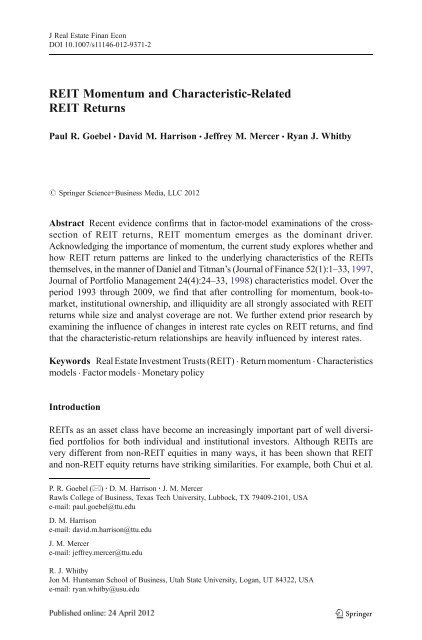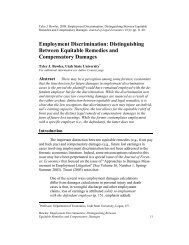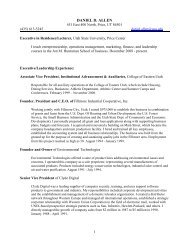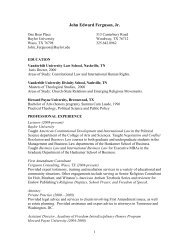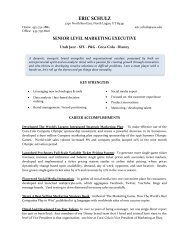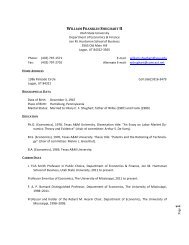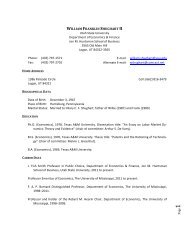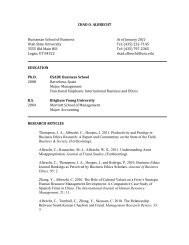REIT Momentum and Characteristic-Related REIT Returns - Jon M ...
REIT Momentum and Characteristic-Related REIT Returns - Jon M ...
REIT Momentum and Characteristic-Related REIT Returns - Jon M ...
You also want an ePaper? Increase the reach of your titles
YUMPU automatically turns print PDFs into web optimized ePapers that Google loves.
J Real Estate Finan Econ<br />
DOI 10.1007/s11146-012-9371-2<br />
<strong>REIT</strong> <strong>Momentum</strong> <strong>and</strong> <strong>Characteristic</strong>-<strong>Related</strong><br />
<strong>REIT</strong> <strong>Returns</strong><br />
Paul R. Goebel & David M. Harrison & Jeffrey M. Mercer & Ryan J. Whitby<br />
# Springer Science+Business Media, LLC 2012<br />
Abstract Recent evidence confirms that in factor-model examinations of the crosssection<br />
of <strong>REIT</strong> returns, <strong>REIT</strong> momentum emerges as the dominant driver.<br />
Acknowledging the importance of momentum, the current study explores whether <strong>and</strong><br />
how <strong>REIT</strong> return patterns are linked to the underlying characteristics of the <strong>REIT</strong>s<br />
themselves, in the manner of Daniel <strong>and</strong> Titman’s (Journal of Finance 52(1):1–33, 1997,<br />
Journal of Portfolio Management 24(4):24–33, 1998) characteristics model. Over the<br />
period 1993 through 2009, we find that after controlling for momentum, book-tomarket,<br />
institutional ownership, <strong>and</strong> illiquidity are all strongly associated with <strong>REIT</strong><br />
returns while size <strong>and</strong> analyst coverage are not. We further extend prior research by<br />
examining the influence of changes in interest rate cycles on <strong>REIT</strong> returns, <strong>and</strong> find<br />
that the characteristic-return relationships are heavily influenced by interest rates.<br />
Keywords Real Estate Investment Trusts (<strong>REIT</strong>) . Return momentum . <strong>Characteristic</strong>s<br />
models . Factor models . Monetary policy<br />
Introduction<br />
<strong>REIT</strong>s as an asset class have become an increasingly important part of well diversified<br />
portfolios for both individual <strong>and</strong> institutional investors. Although <strong>REIT</strong>s are<br />
very different from non-<strong>REIT</strong> equities in many ways, it has been shown that <strong>REIT</strong><br />
<strong>and</strong> non-<strong>REIT</strong> equity returns have striking similarities. For example, both Chui et al.<br />
P. R. Goebel (*) : D. M. Harrison: J. M. Mercer<br />
Rawls College of Business, Texas Tech University, Lubbock, TX 79409-2101, USA<br />
e-mail: paul.goebel@ttu.edu<br />
D. M. Harrison<br />
e-mail: david.m.harrison@ttu.edu<br />
J. M. Mercer<br />
e-mail: jeffrey.mercer@ttu.edu<br />
R. J. Whitby<br />
<strong>Jon</strong> M. Huntsman School of Business, Utah State University, Logan, UT 84322, USA<br />
e-mail: ryan.whitby@usu.edu
(2003a, b) <strong>and</strong> Derwall et al. (2009) use factor models to show that <strong>REIT</strong> returns are<br />
dominated by a momentum effect. The momentum effect in non-<strong>REIT</strong> equity returns<br />
has been described as an anomaly that evades rational explanations by asset pricing<br />
models. Such factor-model findings suggest that <strong>REIT</strong> returns <strong>and</strong> equity returns are<br />
similar with respect to the momentum effect. There exists, however, an alternative<br />
empirical framework with which to examine cross-sectional determinants, that being<br />
the “characteristics” framework of Daniel <strong>and</strong> Titman (1997, 1998).<br />
In this study, we reexamine the influence of momentum <strong>and</strong> other characteristics<br />
on <strong>REIT</strong> returns using the Daniel <strong>and</strong> Titman framework <strong>and</strong> find clear distinctions<br />
between our evidence for <strong>REIT</strong> returns <strong>and</strong> prior studies’ findings for non-<strong>REIT</strong><br />
equity returns. 1 One of the starkest contrasts is found when comparing characteristic<br />
sorted portfolios across different interest rate environments<br />
Motivation <strong>and</strong> Empirical Framework<br />
P.R. Goebel et al.<br />
The ubiquitous Fama <strong>and</strong> French (1993) <strong>and</strong> Carhart (1997) factor models used to<br />
explain patterns in the cross-section of stock <strong>and</strong> <strong>REIT</strong> returns rely on a risk, or<br />
covariance story. Specifically, the return premium for value stocks over growth stocks<br />
is due to the observation that value stocks covary similarly among themselves <strong>and</strong><br />
with the underlying factor that proxies for risk. Though ubiquitous, factor models are<br />
not without controversy. Among the criticisms is that they are empirically motivated<br />
<strong>and</strong> have no theoretical linkage to the underlying fundamental drivers of returns.<br />
While there is much empirical support for factor models, Lewellen et al. (2010),<br />
among others, are highly critical of many of the tests <strong>and</strong> demonstrate that the results<br />
from them can be misleading. 2<br />
Daniel <strong>and</strong> Titman (1997, 1998) provide an alternative framework for explaining<br />
cross-sectional stock return patterns. They show that it is the underlying characteristics<br />
of the stocks (e.g., low book-to-market versus high book-to-market ratios),<br />
rather than the return covariance with a risk factor, that are responsible for crosssectional<br />
return differences. Thus, Daniel <strong>and</strong> Titman offer a characteristics story,<br />
rather than strictly a covariance story. Like factor models, Daniel <strong>and</strong> Titman’s<br />
characteristics model also has detractors (see, for example, Davis et al. 2000, <strong>and</strong><br />
the subsequent “rebuttal” by Daniel et al. 2001).<br />
Derwall et al. (2009), as well as earlier work by Chui et al. (2003a, b), extend non-<br />
<strong>REIT</strong> examinations to an examination of the cross section of <strong>REIT</strong> returns. Perhaps<br />
the most notable <strong>and</strong> consistent finding in these studies is that <strong>REIT</strong> momentum<br />
emerges as the dominant determinant of the cross-section of <strong>REIT</strong> returns. The<br />
competing variables examined in their tests (<strong>and</strong> in earlier studies they build upon)<br />
include size, book-to-market, momentum, volume, turnover, <strong>and</strong> analyst coverage, as<br />
well as the use of the Fama <strong>and</strong> French (1993) <strong>and</strong>Carhart(1997) models.<br />
1 For robustness, in untabulated results we conducted our analysis on all non-<strong>REIT</strong> firms with market<br />
capitalizations greater than $75 million. We find results consistent with prior literature in that returns have a<br />
significantly positive relationship with momentum <strong>and</strong> illiquidity <strong>and</strong> a significantly negative relationship<br />
with institutional ownership <strong>and</strong> analyst coverage. Size <strong>and</strong> book-to-market have the expected signs but are<br />
insignificant.<br />
2 We are not aware of a critical examination of the factor model methodology that focuses solely on <strong>REIT</strong>s.
<strong>REIT</strong> <strong>Momentum</strong> <strong>and</strong> <strong>Characteristic</strong>-<strong>Related</strong> <strong>REIT</strong> <strong>Returns</strong><br />
Interestingly, however, an extension of Daniel <strong>and</strong> Titman’s(1997, 1998) approach to<br />
this issue is missing, providing a key motivation for our study.<br />
In this study, we follow Derwall et al. (2009), Chui et al. (2003a, b), <strong>and</strong> earlier<br />
studies on the cross-section of <strong>REIT</strong> returns, <strong>and</strong> reexamine whether <strong>and</strong> how <strong>REIT</strong><br />
characteristics are related to <strong>REIT</strong> returns, while controlling for the importance of<br />
momentum. Our interest is not in testing an asset pricing model in the sense of looking<br />
for “alpha.” While Derwall et al. (2009) use factor models to provide important insights<br />
regarding momentum’s influenceon<strong>REIT</strong>fundperformancemeasurement<strong>and</strong><br />
comparison, the use of factor models in this study would not have furthered our<br />
underst<strong>and</strong>ing of the drivers of <strong>REIT</strong> returns. Instead, we seek to explore the drivers<br />
of <strong>REIT</strong> returns in Daniel <strong>and</strong> Titman’s characteristics framework while accounting<br />
for the now well-established momentum effect. We are not aware of any studies that<br />
do this. Our extension updates Chui et al. (2003a) data by nearly a decade <strong>and</strong><br />
introduces institutional ownership, a variable known to influence the existence of a value<br />
premium, 3 as a new variable not widely examined in <strong>REIT</strong>s. We also contribute to the<br />
literature by examining the inter-temporal influences of interest rate levels, driven by<br />
Federal Reserve policy rates, on cross-sectional <strong>REIT</strong> returns <strong>and</strong> characteristics.<br />
While past studies have found the Fed’s policy stance to be related to the level of <strong>REIT</strong><br />
returns, we are unaware of studies that examine the influence of changes in policy rates<br />
on the relations between firm characteristics <strong>and</strong> <strong>REIT</strong> returns in a cross-sectional setting.<br />
The <strong>Characteristic</strong>s<br />
Beyond the studies mentioned above, a vast literature examines the cross-sectional<br />
patterns of expected stock <strong>and</strong> <strong>REIT</strong> returns. Among the variables found to be most<br />
strongly related empirically to (non-<strong>REIT</strong>) stock returns are size <strong>and</strong> book-to-market<br />
equity (Fama <strong>and</strong> French 1992), momentum (Jegadeesh <strong>and</strong> Titman 1993), liquidity<br />
(Brennan et al. 1998; Liu2006; <strong>and</strong>Korajczyk<strong>and</strong>Sadka2008), institutional<br />
ownership (Nagel 2005), analyst coverage (Hong et al. 2000; Diether et al. 2002),<br />
<strong>and</strong> monetary policy (Jensen et al. 1996; <strong>and</strong> Jensen <strong>and</strong> Mercer 2002).<br />
Among the variables found to be most strongly related empirically to <strong>REIT</strong> returns<br />
are size <strong>and</strong> book-to-market equity (Peterson <strong>and</strong> Hsieh 1997), momentum (Chui et<br />
al. 2003b; Hung <strong>and</strong> Glascock 2008, 2010), liquidity (Clayton <strong>and</strong> MacKinnon 2000;<br />
Cannon <strong>and</strong> Cole 2011), institutional ownership (Wang et al. 1995), analyst coverage<br />
(Chui et al. 2003a; Devos et al. 2007), <strong>and</strong> monetary policy (Chen et al. 2011; Chang<br />
et al. 2011). Each of these studies provide motivation for the particular variables they<br />
investigate, but in general the <strong>REIT</strong> literature has followed the non-<strong>REIT</strong> asset pricing<br />
literature to similarly motivate the variables. Given the findings of these studies, we<br />
examine the role of each of these variables. 4<br />
3 See Phalippou (2008) for recent evidence.<br />
4 We do not examine idiosyncratic volatility for several reasons. First, measuring idiosyncratic risk<br />
requires, by definition, an assumed factor (risk) model. We are, however, simply examining return differences<br />
on portfolios with different characteristics, a la Daniel <strong>and</strong> Titman (1998), <strong>and</strong> choose to remain<br />
agnostic regarding factor models. Second, Hung <strong>and</strong> Glascock (2010) provide evidence that differences in<br />
idiosyncratic risk are positively related to momentum returns, which we implicitly control for in our double<br />
sorting procedures.
P.R. Goebel et al.<br />
Our sample consists of all equity <strong>REIT</strong>S from the CRSP database listed by<br />
PERMNOs in Feng et al. (2011) overtheperiod1993–2009. 5 We calculate<br />
monthly observations of each of the characteristics for every <strong>REIT</strong> in our sample,<br />
<strong>and</strong> define them as follows. Size (MV) is the month-end product of common<br />
shares outst<strong>and</strong>ing <strong>and</strong> price per share from CRSP. Book-to-market (B/M) is<br />
calculated as the book value of common equity from Compustat in year t-1,<br />
where the year starts in June <strong>and</strong> ends in May, divided by the firm’s market<br />
capitalization in December of year t-1. <strong>Momentum</strong> (MOM) is the compounded<br />
6-month stock return from month t-7 to month t-2. Illiquidity<br />
(ILL) is the st<strong>and</strong>ardized turnover-adjusted number of zero daily trading<br />
volumes over the prior 12 months as defined in Liu (2006). 6 Institutional<br />
ownership (IO) is measured as the percent of shares outst<strong>and</strong>ing held by institutions<br />
in the previous quarter as reported in the Thomson Reuters Institutional Holdings<br />
database. Analyst Coverage (COV) is defined as a binary indicator variable<br />
taking on the value of one if the firm had one or more analyst estimates in<br />
IBES, <strong>and</strong> zero otherwise.<br />
Akeycontributionofthisstudyisouruseofthecharacteristic-sortprocedure<br />
of Daniel <strong>and</strong> Titman (1997, 1998). This procedure, unlike a factor model<br />
approach, allows us to easily examine the influence of interest rates, a second key<br />
contribution presented later in the study. At the end of every month we rank all <strong>REIT</strong>s<br />
on each of the characteristics <strong>and</strong> assign each <strong>REIT</strong> to one of three portfolios. The<br />
“High” portfolio contains the 1/3 of <strong>REIT</strong>s with the highest value of the particular<br />
characteristic <strong>and</strong> the “Low” portfolio contains the 1/3 of <strong>REIT</strong>s with the lowest value<br />
of the particular characteristic. 7 Following Derwall et al. (2009), we then obtain the<br />
next month’s return on every <strong>REIT</strong> <strong>and</strong> calculate equally-weighted returns for the<br />
High, Medium, <strong>and</strong> Low portfolios. This procedure is repeated for every month in the<br />
5 There is little disagreement that the financial crisis of the last few years has had a major impact on<br />
financial markets <strong>and</strong> participants’ investment decisions. Whether ‘this time is different’ is debatable, <strong>and</strong><br />
not something we are prepared to take up in this study. We do, however, wish to allow for the possibility<br />
that the crisis might have produced anomalous <strong>and</strong> unknown pricing relationships during this period. To<br />
that end, we initially select August 2007 as the end of the sample because it is the first month (during the<br />
crisis period) that the Federal Reserve’s FOMC conducted unscheduled meetings (two in fact), <strong>and</strong> the first<br />
cut in policy rates came in this month (i.e., the prior policy rate change was an increase in July 2006). This<br />
change-in-direction in Federal Reserve policy rates becomes important in our subsequent analyses. In<br />
unreported results using this truncated sample, we find qualitatively similar results to those reported over<br />
the full period. Similarly, we selected 1993 as the beginning of the full sample as this is the beginning of the<br />
modern <strong>REIT</strong> era. In the Appendix we report the summary statistics <strong>and</strong> results of the analysis incorporating<br />
the earlier <strong>REIT</strong> sample beginning in 1982 <strong>and</strong> running through 1992.<br />
6 Our liquidity measure is analogous to LM12 from Liu (2006). Our liquidity measure is highly correlated<br />
with the st<strong>and</strong>ard turnover measures with correlation coefficients between 0.60 <strong>and</strong> 0.80, depending on the<br />
turnover measure <strong>and</strong> time period used. However, we prefer LM12 because it incorporates several<br />
dimensions of liquidity, which include turnover, the continuity of trade or lock in risk, the trading quantity,<br />
<strong>and</strong> the cost of trading. See Liu (2006) for a more thorough discussion.<br />
7 For robustness, we also examined portfolios where the sample was sorted into fifths or halves.<br />
Qualitatively similar results were found using both methodologies <strong>and</strong> are not reported. While using fifths<br />
often increases the spread between high <strong>and</strong> low portfolios, the reduction in observations in each portfolio<br />
also increases the likelihood that the results can be driven by an outlier. We feel that using thirds is more<br />
informative than halves because it demonstrates a relationship’s monotonicity or lack thereof.
<strong>REIT</strong> <strong>Momentum</strong> <strong>and</strong> <strong>Characteristic</strong>-<strong>Related</strong> <strong>REIT</strong> <strong>Returns</strong><br />
sample. By focusing on one-month holding periods, we minimize the impact of<br />
momentum on the return measurement 8 (thereby allowing us to measure the effect<br />
of the other characteristics), but still allow for momentum in the construction of the<br />
portfolios.<br />
Table 1 provides summary statistics for each of the characteristic variables.<br />
The sample contains 311 <strong>REIT</strong>s from 1993 to 2009, resulting in 35,198 firmyear-month<br />
observations. Consistent with previous studies of <strong>REIT</strong> markets, the<br />
typical firm in our sample has a market capitalization of approximately $1.5<br />
billion with an average Book-to-Market ratio of 0.855. Not surprisingly, we<br />
also observe a dramatic increase in <strong>REIT</strong> market values preceding the financial<br />
crisis <strong>and</strong> a stunning reversal in Book-to-Market values after its onset. Finally,<br />
the summary statistics in Table 1 readily illustrate the dramatic increase in liquidity,<br />
Institutional Ownership, <strong>and</strong> Analyst Coverage of <strong>REIT</strong> markets during our sample<br />
period.<br />
Table 2 further delineates the attributes of our sample <strong>and</strong> presents the<br />
correlation coefficients between each pair of firm characteristics. While the vast<br />
majority of observed correlations are statistically significant, only four characteristic<br />
pairs exhibit coefficient estimates greater than 0.25 in absolute value.<br />
Specifically, Market Value appears to be positively correlated with both<br />
Institutional Ownership (ρ00.413) <strong>and</strong> Analyst Coverage (ρ00.386), while<br />
Institutional Ownership is inversely related to Illiquidity (ρ0−0.383) <strong>and</strong> directly<br />
related to Analyst Coverage (ρ00.522).<br />
The characteristic sorted <strong>REIT</strong> returns for the High, Medium, <strong>and</strong> Low portfolios<br />
formed on each of the characteristics are provided in Table 3. We present mean<br />
monthly returns, st<strong>and</strong>ard deviation of monthly returns, median returns, <strong>and</strong> p-values<br />
from t-tests of whether the <strong>REIT</strong> returns in the High versus Low portfolios are<br />
different. Consistent with the existing literature, the descriptive analysis of our results<br />
focuses on differences in mean returns across portfolio characteristics. Given the<br />
relatively small portfolio groupings in some years, particularly when sorted on multiple<br />
characteristics, we acknowledge the potential for a small group of outliers to materially<br />
influence individual results. As such, throughout our analyses we also report median<br />
portfolio returns. In general, the results from the two alternative metrics are qualitatively<br />
similar. 9<br />
The t-tests reveal significantly different mean returns on High versus Low<br />
portfolios when formed on <strong>Momentum</strong>, Institutional Ownership, <strong>and</strong> Illiquidity.<br />
As such, we implicitly control for <strong>Momentum</strong> in our subsequent analysis<br />
through a double sorting procedure. As expected, low Institutional Ownership<br />
portfolio mean returns are shown to be higher than high Institutional Ownership<br />
portfolio returns. Also as expected, mean returns from portfolios of illiquid<br />
<strong>REIT</strong>s are significantly higher than mean returns from portfolios of liquid<br />
<strong>REIT</strong>s. Market Value, Book-to-Market, <strong>and</strong> Analyst Coverage do not appear<br />
to be significantly related to average portfolio returns in this univariate setting.<br />
8<br />
This difference in calculations is why the <strong>Momentum</strong> returns we report are not as large as those found in<br />
previous studies.<br />
9<br />
We thank an anonymous referee for bringing this point to our attention.
Table 1 Summary statistics<br />
Year <strong>REIT</strong>s Market value<br />
equity<br />
Book to<br />
market<br />
Illiquidity Institutional<br />
ownership<br />
6 month<br />
return<br />
Analyst<br />
coverage<br />
1993 172 205 2.399 23.886 23.72 % 17.17 % 17.04 %<br />
1994 213 234 1.343 18.391 33.97 % 4.83 % 6.97 %<br />
1995 215 262 1.373 16.578 36.96 % 4.41 % 3.36 %<br />
1996 219 357 0.894 15.615 38.78 % 10.31 % 4.19 %<br />
1997 221 586 0.723 12.175 43.93 % 15.77 % 5.29 %<br />
1998 216 739 0.727 9.295 43.99 % 0.62 % 5.78 %<br />
1999 200 715 0.913 9.404 42.19 % −1.22 % 15.26 %<br />
2000 187 756 1.036 9.727 40.98 % 2.64 % 10.92 %<br />
2001 180 873 1.163 9.919 39.93 % 10.94 % 35.33 %<br />
2002 173 1010 0.980 9.089 45.56 % 7.50 % 56.53 %<br />
2003 173 1146 1.058 9.039 51.58 % 9.42 % 65.41 %<br />
2004 182 1542 0.666 5.342 59.99 % 12.32 % 71.44 %<br />
2005 179 1807 0.557 4.119 64.31 % 11.53 % 78.19 %<br />
2006 172 2310 0.587 5.394 68.30 % 8.23 % 80.43 %<br />
2007 151 2652 0.506 5.050 70.83 % 5.39 % 82.05 %<br />
2008 129 2101 0.628 6.990 72.85 % −8.29 % 81.82 %<br />
2009 124 1535 1.315 6.491 71.21 % −2.15 % 87.53 %<br />
Average 168 1495 0.855 7.324 57.07 % 5.12 % 60.45 %<br />
The sample contains 311 unique equity <strong>REIT</strong>s from 1993 to 2009. This results in 35,198 firm-year-month<br />
observations. Market value of equity is calculated by multiplying shares outst<strong>and</strong>ing <strong>and</strong> the end of month<br />
price from CRSP. The book-to-market ratio uses prior year book values <strong>and</strong> current month market values.<br />
Illiquidity is calculated following Liu (2006). Institutional ownership is the percent of shares outst<strong>and</strong>ing<br />
held by institutions. The 6-month stock return is a compounded return from t-7 to t-2. Analyst coverage is<br />
the percent of <strong>REIT</strong>s with analyst coverage in IBES<br />
Table 2 Correlations<br />
Market value<br />
equity<br />
Book to market −0.113 (0.000)<br />
Book to<br />
market<br />
Illiquidity −0.165 (0.000) 0.204 (0.000)<br />
Illiquidity Institutional<br />
ownership<br />
Institutional ownership 0.413 (0.000) −0.189 (0.000) −0.383 (0.000)<br />
6 month return 0.035 (0.023) 0.019 (0.353) 0.004 (0.407) −0.032 (0.086)<br />
P.R. Goebel et al.<br />
6 month return<br />
Analyst coverage 0.386 (0.000) −0.090 (0.064) −0.238 (0.000) 0.522 (0.000) −0.012 (0.026)<br />
The sample contains 311 unique equity <strong>REIT</strong>s from 1993 to 2009. This results in 35,198 firm-year-month<br />
observations. Market value of equity is calculated by multiplying shares outst<strong>and</strong>ing <strong>and</strong> the end of month<br />
price from CRSP. The book-to-market ratio uses prior year book values <strong>and</strong> current month market values.<br />
Illiquidity is calculated following Liu (2006). Institutional ownership is the percent of shares outst<strong>and</strong>ing<br />
held by institutions. The 6-month stock return is a compounded return from t-7 to t-2. Analyst coverage is<br />
an indicator variable that takes the value of 1 if the <strong>REIT</strong> is covered by an analyst in IBES
<strong>REIT</strong> <strong>Momentum</strong> <strong>and</strong> <strong>Characteristic</strong>-<strong>Related</strong> <strong>REIT</strong> <strong>Returns</strong><br />
Table 3 <strong>Characteristic</strong> sorted <strong>REIT</strong> returns<br />
Market value<br />
equity<br />
Illiquidity Analyst<br />
coverage<br />
Institutional<br />
ownership<br />
Book to<br />
market<br />
Median return <strong>Momentum</strong><br />
return<br />
St<strong>and</strong>ard<br />
deviation<br />
Equally weighted<br />
return<br />
MVL 1.05 % 5.55 % 0.95 % 5.18 % 1.554 25.20 % 29.955 26.63 % 108<br />
MVM 1.20 % 5.98 % 1.40 % 6.48 % 0.738 55.40 % 1.086 46.50 % 593<br />
MV H 1.35 % (0.321) 5.92 % (
Interestingly, results obtained from examining median returns are somewhat<br />
different. Specifically, Market Value, Illiquidity, <strong>and</strong> Analyst Coverage all<br />
appear to be positively related to median returns, while <strong>Momentum</strong> <strong>and</strong><br />
Institutional Ownership lose their previously reported significance levels.<br />
Federal Reserve Monetary Policy <strong>and</strong> Policy Rates<br />
P.R. Goebel et al.<br />
Jensen <strong>and</strong> Mercer (2002) <strong>and</strong> Becher et al. (2008) provide evidence supporting a<br />
link between cross-sectional stock returns <strong>and</strong> changes in the Federal Reserve’s<br />
policy rates. Specifically, they show that return premiums associated with crosssectional<br />
characteristics (such as book-to-market) are generally higher in periods of<br />
falling policy rates which, if the policy stance is counter-cyclical, will more<br />
typically coincide with periods of economic slowdown <strong>and</strong> periods of lower<br />
consumption. Jensen <strong>and</strong> Moorman (2010) find inter-temporal variation in the<br />
return premium to illiquid stocks that is directly related to the same Federal Reserve<br />
policy rates. Buetow <strong>and</strong> Johnson (2001) examine the level (rather than the cross<br />
section) of <strong>REIT</strong> returns <strong>and</strong> Fed policy rates <strong>and</strong> find that <strong>REIT</strong> returns are<br />
significantly higher in periods of falling policy rates versus periods of rising policy<br />
rates, while Darrat <strong>and</strong> Glascock (1989) conclude that a measure of monetary policy<br />
(Granger) causes changes in real estate returns.<br />
In contrast, Mueller <strong>and</strong> Pauley (1995) find little relation between interest rates<br />
<strong>and</strong> <strong>REIT</strong> returns, while Chen et al. (2011) fullsampleresultsfailtoidentify<br />
significant linkages between E<strong>REIT</strong> returns <strong>and</strong> monetary policy changes.<br />
Interestingly, Chen et al. (2011) also demonstrate that the influence of monetary<br />
policy on E<strong>REIT</strong> returns may well be contingent on market states (bull vs. bear<br />
markets) <strong>and</strong> expected returns. Specifically, using quantile regression, they conclude<br />
monetary policy changes only significantly influence E<strong>REIT</strong> returns during bull<br />
markets when investors possess relatively low expectations for future real estate price<br />
increases.<br />
From a traditional real estate valuation perspective, required returns <strong>and</strong> capitalization<br />
rates in commercial property markets are determined by a variety of factors<br />
including income growth expectations, capital market risk premiums, <strong>and</strong> equilibrium<br />
market interest rates. 10 Based on this evidence, we control for Fed policy rates in the<br />
analysis via the creation of characteristic-sorted portfolios over periods of falling<br />
policy rates (expansive monetary policy) versus periods of rising policy rates<br />
(restrictive monetary policy).<br />
Following Jensen et al. (1996), we classify every month as either an expansive<br />
policy month or a restrictive policy month. The rule is: expansive policy phases of the<br />
cycle begin when a discount rate decrease follows a discount rate increase, <strong>and</strong> ends<br />
with the next discount rate increase; restrictive policy phases of the cycle begin when<br />
a discount rate increase follows a discount rate decrease, <strong>and</strong> ends with the next<br />
10 Recent studies find that there may be additional drivers of cap rates, such as investor sentiment (Clayton<br />
et al. 2009) or growth of debt within the economy (Chervachidze <strong>and</strong> Wheaton 2010).
<strong>REIT</strong> <strong>Momentum</strong> <strong>and</strong> <strong>Characteristic</strong>-<strong>Related</strong> <strong>REIT</strong> <strong>Returns</strong><br />
Table 4 <strong>Characteristic</strong> sorted <strong>REIT</strong> returns conditioned on monetary policy<br />
Restrictive Expansive<br />
Mean Median Mean Median<br />
MVL 0.87 % 0.88 % 1.17 % 0.97 %<br />
MVM 1.04 % 0.67 % 1.30 % 1.68 %<br />
MV H 1.41 % (0.020) 1.52 % (0.001) 1.32 % (0.265) 1.77 % (0.031)<br />
B/ML 1.24 % 1.15 % 0.91 % 1.50 %<br />
B/MM 0.98 % 1.24 % 1.12 % 1.36 %<br />
B/M H 1.11 % (0.362) 1.09 % (0.419) 1.82 % (0.066) 1.72 % (0.298)<br />
MOML 0.99 % 0.95 % 1.25 % 1.73 %<br />
MOMM 1.12 % 1.00 % 1.23 % 1.79 %<br />
MOM H 1.25 % (0.002) 1.26 % (0.037) 1.14 % (0.489) 1.48 % (0.168)<br />
IOL 1.00 % 1.24 % 1.68 % 1.73 %<br />
IOM 0.95 % 0.94 % 1.00 % 1.47 %<br />
IO H 1.32 % (0.185) 1.18 % (0.596) 1.00 % (0.000) 1.42 % (0.095)<br />
ILLL 0.90 % 0.64 % 1.10 % 1.43 %<br />
ILLM 1.16 % 1.03 % 1.12 % 1.39 %<br />
ILL H 1.27 % (0.045) 1.09 % (0.002) 1.76 % (0.011) 1.50 % (0.172)<br />
COV0 1.19 % 1.10 % 1.13 % 1.51 %<br />
COV1 1.02 % (0.485) 0.55 % (0.001) 1.13 % (0.773) 1.25 % (0.331)<br />
P-values from t-tests between equity <strong>REIT</strong> returns from low <strong>and</strong> high portfolios are reported in parentheses.<br />
Each month is classified as either an expansive policy month or a restrictive policy month according to<br />
discount rate changes. <strong>Returns</strong> are monthly. Market value (MV) of equity is calculated by multiplying<br />
shares outst<strong>and</strong>ing <strong>and</strong> the end of month price from CRSP. The book-to-market (B/M) ratio uses prior year<br />
book values <strong>and</strong> current month market values. Illiquidity (ILL) is calculated following Liu (2006).<br />
Institutional ownership (IO) is the percent of shares outst<strong>and</strong>ing held by institutions. The 6-month stock<br />
return is a compounded return from t-7 to t-2. Analyst coverage (COV) is the percent of <strong>REIT</strong>s with analyst<br />
coverage in IBES<br />
discount rate decrease. This approach is followed by numerous researchers; for a<br />
recent example see Buetow et al. (2009).<br />
Table 4 provides summary statistics for the High, Medium, <strong>and</strong> Low portfolios<br />
formed on each of the characteristics in both restrictive <strong>and</strong> expansive monetary policy<br />
environments. We present mean <strong>and</strong> median monthly returns, <strong>and</strong> p-values from t-tests<br />
of whether the <strong>REIT</strong> returns in the High versus Low characteristic sorted portfolios<br />
are different, for both policy environments. With respect to mean returns, the<br />
policy environment does not appear to alter the relation of Illiquidity or Analyst<br />
Coverage sorted portfolio returns. That is, the relations look similar in both restrictive<br />
<strong>and</strong> expansive environments, with Illiquidity increasing returns <strong>and</strong> Analyst<br />
Coverage being unrelated to mean returns.<br />
Regarding size, we see that large <strong>REIT</strong>s significantly outperform small <strong>REIT</strong>s in a<br />
restrictive environment, yet when rates are falling in an expansive environment this<br />
return difference is statistically insignificant. This result is inconsistent with the
evidence for non-<strong>REIT</strong> common stocks, where premiums are larger during periods of<br />
loosening monetary policy. 11<br />
Next, we observe that high Book-to-Market <strong>REIT</strong>S (marginally) outperform low<br />
Book-to-Market <strong>REIT</strong>s during periods of expansive credit, but this relationship is<br />
non-existent during restrictive periods. Given the marginal significance of this relationship,<br />
we refrain from drawing strong conclusions as to the consistency with<br />
broader finance literature findings. Turning to <strong>Momentum</strong>, we find winner portfolios<br />
outperform loser portfolios during restrictive periods, but no differences are observed<br />
during expansionary policy periods. This result is again inconsistent with the findings<br />
for non-<strong>REIT</strong>s, where Jensen <strong>and</strong> Mercer (2002) <strong>and</strong> Becher et al. (2008) find return<br />
premiums are more significant during periods of monetary expansion.<br />
Finally, the relationship between Institutional Ownership portfolio returns is also<br />
impacted by the monetary policy environment. Specifically, low Institutional<br />
Ownership portfolios provide higher portfolio returns when rates are falling in<br />
expansive environments, while no significant return differences are found during<br />
restrictive monetary policy environments. This latter result is consistent with the<br />
finding for non-<strong>REIT</strong> common stocks that higher returns are required on stocks lessheld<br />
by institutional investors when the Fed is loosening.<br />
To summarize, in periods of falling policy rates under an expansive monetary<br />
policy, when cross-sectional risk premiums are typically different (higher), we find<br />
significantly higher mean returns on <strong>REIT</strong>s with 1) higher Book-to-Market ratios, 2)<br />
lower Institutional Ownership <strong>and</strong> 3) higher Illiquidity. In periods of rising rates<br />
under a restrictive monetary policy, when cross-sectional risk premiums are typically<br />
not different (lower), we find significantly higher mean returns on <strong>REIT</strong>s with 1)<br />
larger Market Value, 2) higher <strong>Momentum</strong>, <strong>and</strong> 3) greater Illiquidity. Thus, like the<br />
evidence found for non-<strong>REIT</strong> common stocks, there is clear support for the hypothesis<br />
that <strong>REIT</strong> characteristics are related to returns differently depending on macroeconomic<br />
conditions, in this instance being proxied by the Fed policy-rate cycle.<br />
However, for several of these characteristics, the relation runs in the opposite<br />
direction from that found for non-<strong>REIT</strong> common stocks.<br />
Double Sorts<br />
P.R. Goebel et al.<br />
Like Chui et al. (2003a), we next present the results from a double-sort procedure.<br />
They form characteristic-based portfolios (first on size, then separately on analyst<br />
coverage, turnover, <strong>and</strong> finally book-to-market), <strong>and</strong> then sub-divide these portfolios<br />
into two momentum portfolios (past winners versus past losers) to report the effect of<br />
each of the characteristics on the momentum profits. Because it is clear that momentum<br />
continues to be a dominant characteristic (for example, see Fama <strong>and</strong> French’s<br />
11 One possible explanation for this observed result is the unique regulatory environment in which <strong>REIT</strong>s<br />
operate. Specifically, in order to retain pass-through status with regard to federal income taxation, <strong>REIT</strong>s<br />
must distribute at least 90 % of taxable income to their shareholders in the form of dividends. As such,<br />
<strong>REIT</strong>s generally cannot fund growth endogenously through retained earnings <strong>and</strong> must therefore systematically<br />
return to the capital markets. Thus, in periods of restrictive credit, large, transparent <strong>REIT</strong>s may<br />
have an easier time continuing to obtain credit on favorable terms. See, for example, Capozza <strong>and</strong> Seguin<br />
(1999), Ambrose <strong>and</strong> Linneman (2001) <strong>and</strong> Danielsen et al. (2009).
<strong>REIT</strong> <strong>Momentum</strong> <strong>and</strong> <strong>Characteristic</strong>-<strong>Related</strong> <strong>REIT</strong> <strong>Returns</strong><br />
Table 5 <strong>Momentum</strong> <strong>and</strong> characteristic sorted <strong>REIT</strong> returns<br />
MOML MOMM MOMH<br />
Mean Median Mean Median Mean Median<br />
MV L 1.00 % 0.58 % 1.03 % 1.05 % 1.00 % 1.02 %<br />
MV M 1.46 % 1.38 % 1.18 % 1.39 % 1.22 % 1.26 %<br />
MVH 1.31 % (0.402) 1.53 % (0.005) 1.35 % (0.866) 1.91 % (0.002) 1.31 % (0.129) 1.73 % (0.036)<br />
B/ML 0.89 % 1.31 % 1.22 % 1.49 % 1.05 % 1.45 %<br />
B/M M 1.28 % 1.00 % 1.00 % 1.72 % 1.04 % 1.22 %<br />
B/MH 1.66 % (0.032) 1.40 % (0.525) 1.37 % (0.176) 1.57 % (0.237) 1.45 % (0.323) 1.64 % (0.183)<br />
IOL 1.52 % 1.42 % 1.36 % 1.64 % 1.31 % 1.43 %<br />
IO M 1.21 % 1.29 % 1.08 % 1.39 % 0.95 % 1.18 %<br />
IOH 0.95 % (0.041) 1.04 % (0.061) 1.05 % (0.646) 1.45 % (0.749) 1.17 % (0.875) 0.98 % (0.024)<br />
ILLL 0.75 % 0.90 % 1.04 % 1.55 % 1.05 % 1.26 %<br />
ILL M 1.31 % 1.35 % 1.17 % 1.51 % 1.18 % 1.09 %<br />
ILLH 1.71 % (0.000) 1.29 % (0.042) 1.35 % (0.080) 1.54 % (0.863) 1.31 % (0.162) 1.41 % (0.448)<br />
COV0 1.43 % 1.13 % 1.89 % 1.44 % 1.11 % 1.11 %<br />
COV 1 1.39 % (0.497) 1.01 % (0.393) 1.12 % (0.136) 1.23 % (0.376) 0.83 % (0.384) 1.08 % (0.843)<br />
P-values from t-tests between equity <strong>REIT</strong> returns from low <strong>and</strong> high portfolios are reported in parentheses.<br />
To control for momentum (MOM), portfolios are formed by first sorting on momentum <strong>and</strong> then the<br />
respective characteristics. <strong>Returns</strong> are monthly. Market value (MV) of equity is calculated by multiplying<br />
shares outst<strong>and</strong>ing <strong>and</strong> the end of month price from CRSP. The book-to-market (B/M) ratio uses prior year<br />
book values <strong>and</strong> current month market values. Illiquidity (ILL) is calculated following Liu (2006).<br />
Institutional ownership (IO) is the percent of shares outst<strong>and</strong>ing held by institutions. The 6-month stock<br />
return is a compounded return from t-7 to t-2. Analyst coverage (COV) is the percent of <strong>REIT</strong>s with analyst<br />
coverage in IBES<br />
2011 recent evidence), we instead reverse the order of the double-sorts <strong>and</strong> explore<br />
the influence of the characteristics after controlling for momentum. This is also<br />
consistent with our empirical approach in which we examine only the next-month<br />
return after portfolio formation. That is, we do not measure the impact of momentum,<br />
which plays out over several more months than our return horizon.<br />
Table 5 presents mean monthly returns, median monthly returns <strong>and</strong> p-values from ttests<br />
for return differences across the portfolios. In examining mean returns, the first<br />
entries indicate that in both loser <strong>and</strong> winner portfolios, Market Value does not<br />
appear to be related to returns. This is also the case for the previously reported<br />
univariate results before controlling for the monetary policy environment.<br />
Similarly, in both the loser <strong>and</strong> winner portfolios, the performance of low<br />
(no) Analyst Coverage <strong>REIT</strong>s is indistinguishable from that of high (covered)<br />
Analyst Coverage <strong>REIT</strong>s. This is again consistent with the univariate results.<br />
Thus, controlling for <strong>Momentum</strong> does not appear to alter the return relationships<br />
for Market Value <strong>and</strong> Analyst Coverage, which again is inconsistent with<br />
the evidence for non-<strong>REIT</strong> common stocks. In loser portfolios, the high Bookto-Market<br />
portfolio provides significantly higher returns than the low Book-to-<br />
Market portfolio. However, there is no significant return difference observable
in winner portfolios. Similarly, in loser portfolios the low Institutional<br />
Ownership portfolio again provides significantly higher returns than the high<br />
Institutional Ownership portfolio, while there is no significant return difference<br />
in winner portfolios. Regarding liquidity, we see that the less-liquid portfolio<br />
outpaces the more-liquid portfolio in loser portfolios, but once again there is no<br />
significant return difference in winner portfolios. Thus, in the portfolios of<br />
<strong>REIT</strong>s with the lowest momentum, there is a mean return premium associated<br />
with higher Book-to-Market values, less Institutional Ownership, <strong>and</strong> greater<br />
Illiquidity. However, these return premiums disappear in portfolios of <strong>REIT</strong>s<br />
with the highest <strong>Momentum</strong>.<br />
Double Sorts with Fed Policy Rates<br />
P.R. Goebel et al.<br />
We next present the results from a double-sort procedure incorporating monetary<br />
policy. Similar to our results presented in Table 5, we form characteristic-based<br />
portfolios (sorting first on momentum, then separately on each of the remaining<br />
characteristics). We then compare the portfolios formed in restrictive versus expansive<br />
monetary policy periods to report the effect of each of the characteristics after<br />
incorporating monetary policy.<br />
Table 6 presents mean monthly returns <strong>and</strong> p-values from t-tests for average <strong>REIT</strong><br />
return differences across the portfolios. With respect to Market Value, placing<br />
our findings in the context of Table 4, the significant relationship for Market Value<br />
in the restrictive monetary environment appears to be robust across <strong>Momentum</strong><br />
portfolios. Continuing, in both the loser <strong>and</strong> winner portfolios, the performance of<br />
low Book-to-Market <strong>REIT</strong>s is indistinguishable from that of high Book-to-Market<br />
<strong>REIT</strong>s during restrictive environments. On the other h<strong>and</strong>, during expansionary<br />
periods <strong>and</strong> within loser portfolios, high Book-to-Market <strong>REIT</strong>s marginally outperform<br />
their low Book-to-Market counterparts. This is again consistent with the results<br />
in Tables 3 <strong>and</strong> 4. Thus, controlling for <strong>Momentum</strong> does not appear to significantly<br />
alter the return relationships for Market Value<strong>and</strong>Book-to-Market.Inwinner<br />
portfolios in restrictive monetary policy periods, the high Institutional Ownership<br />
portfolio provides significantly higher returns than the low Institutional Ownership<br />
portfolio. During expansionary times, high Intuitional Ownership firms exhibit significantly<br />
lower returns than their low Institutional Ownership counterparts. This<br />
latter result is robust across both winner <strong>and</strong> loser portfolios, <strong>and</strong> again clearly<br />
demonstrates the potential impact of monetary policy on <strong>REIT</strong> return relationships.<br />
Regarding Illiquidity, as in Tables 4 <strong>and</strong> 5, we see that the less-liquid portfolio<br />
outperforms the more-liquid counterpart in loser portfolios across both the restrictive<br />
<strong>and</strong> expansive monetary policy environments. In winner portfolios, no significant<br />
return differences are found during either monetary policy environment. Finally,<br />
portfolio returns sorted on Analyst Coverage appear invariant to our <strong>Momentum</strong><br />
<strong>and</strong> monetary policy environment groupings.<br />
To summarize, in the portfolios of <strong>REIT</strong>s with the lowest <strong>Momentum</strong>, there is a<br />
return premium associated with higher Market Values during restrictive policy
<strong>REIT</strong> <strong>Momentum</strong> <strong>and</strong> <strong>Characteristic</strong>-<strong>Related</strong> <strong>REIT</strong> <strong>Returns</strong><br />
Table 6 <strong>Momentum</strong> <strong>and</strong> characteristic sorted <strong>REIT</strong> returns conditioned on monetary policy<br />
MOM L MOM M MOM H<br />
Mean Median Mean Median Mean Median<br />
Panel A: Restrictive monetary policy environment<br />
MV L 0.92 % 0.40 % 0.79 % 0.83 % 1.00 % 0.94 %<br />
MV M 0.70 % 0.09 % 1.12 % 1.04 % 1.24 % 0.91 %<br />
MV H 1.36 % (0.034) 1.16 % (0.003) 1.44 % (0.008) 1.57 % (0.002) 1.49 % (0.016) 1.68 % (0.002)<br />
B/M L 1.13 % 0.87 % 1.18 % 1.11 % 1.27 % 1.26 %<br />
B/M M 0.93 % 0.87 % 0.96 % 1.53 % 1.12 % 1.15 %<br />
B/M H 0.98 % (0.625) 0.92 % (0.778) 1.19 % (0.815) 1.12 % (0.869) 1.31 % (0.986) 1.33 % (0.754)<br />
IO L 1.00 % 1.19 % 1.05 % 0.97 % 0.93 % 0.78 %<br />
IOM 0.91 % 1.15 % 1.08 % 0.84 % 1.22 % 1.15 %<br />
IO H 0.97 % (0.686) 0.61 % (0.036) 1.23 % (0.150) 1.66 % (0.074) 1.47 % (0.010) 1.56 % (0.001)<br />
ILL L 0.50 % 0.64 % 0.95 % 1.20 % 1.20 % 1.22 %<br />
ILL M 1.00 % 0.89 % 1.19 % 0.77 % 1.25 % 1.02 %<br />
ILL H 1.46 % (0.000) 1.14 % (0.001) 1.20 % (0.027) 1.29 % (0.616) 1.28 % (0.764) 1.52 % (0.382)<br />
COV 0 0.68 % 0.88 % 0.86 % 0.61 % 0.78 % 0.78 %<br />
COV 1 0.31 % (0.128) 0.42 % (0.283) 0.97 % (0.167) 1.01 % (0.066) 0.80 % (0.638) 1.19 % (0.053)<br />
Panel B: Expansive monetary policy environment<br />
MVL 1.20 % 1.22 % 1.52 % 1.20 % 1.29 % 1.00 %<br />
MV M 1.64 % 1.28 % 1.37 % 1.87 % 1.36 % 1.30 %<br />
MV H 1.08 % (0.394) 1.30 % (0.741) 1.40 % (0.258) 1.88 % (0.043) 1.19 % (0.961) 1.60 % (0.001)<br />
B/M L 1.01 % 1.64 % 1.41 % 1.70 % 1.13 % 1.41 %<br />
B/M M 1.16 % 1.02 % 1.17 % 1.48 % 1.05 % 1.15 %<br />
B/M H 1.83 % (0.074) 1.60 % (0.818) 1.72 % (0.199) 1.82 % (0.559) 1.71 % (0.235) 1.67 % (0.464)<br />
IO L 1.58 % 1.59 % 1.79 % 2.02 % 1.68 % 1.27 %<br />
IO M 1.35 % 1.41 % 1.18 % 1.51 % 1.03 % 1.16 %<br />
IOH 0.89 % (0.028) 1.23 % (0.376) 1.15 % (0.039) 1.50 % (0.001) 1.00 % (0.042) 1.27 % (0.961)<br />
ILL L 0.91 % 1.04 % 1.36 % 1.71 % 1.06 % 1.18 %<br />
ILL M 1.23 % 1.61 % 1.29 % 1.70 % 1.23 % 1.22 %<br />
ILL H 1.78 % (0.008) 1.42 % (0.022) 1.63 % (0.142) 1.73 % (0.751) 1.57 % (0.270) 1.26 % (0.499)<br />
COV 0 2.01 % 1.46 % 1.50 % 1.34 % 1.58 % 1.34 %<br />
COV 1 2.04 % (0.683) 1.49 % (0.711) 1.72 % (0.294) 1.50 % (0.106) 1.52 % (0.566) 0.93 % (0.058)<br />
P-values from t-tests between equity <strong>REIT</strong> returns from low <strong>and</strong> high portfolios are reported in parentheses.<br />
Each month is classified as either an expansive policy month or a restrictive policy month according to discount<br />
rate changes. <strong>Returns</strong> are monthly. Market value (MV) of equity is calculated by multiplying shares outst<strong>and</strong>ing<br />
<strong>and</strong> the end of month price from CRSP. The book-to-market (B/M) ratio uses prior year book values <strong>and</strong> current<br />
month market values. Illiquidity (ILL) is calculated following Liu (2006). Institutional ownership (IO) is the<br />
percent of shares outst<strong>and</strong>ing held by institutions. The 6-month stock return is a compounded return from t-<br />
7 to t-2. Analyst coverage (COV) is the percent of <strong>REIT</strong>s with analyst coverage in IBES<br />
environments, higher Book-to-Market <strong>and</strong> lower Institutional Ownership during<br />
expansionary environments, <strong>and</strong> higher Illiquidity regardless of a restrictive or
expansive monetary policy environment. In portfolios of <strong>REIT</strong>s with the highest<br />
momentum, there are mean return premiums associated with larger Market Values<br />
during periods of restrictive monetary policy, while high Institutional Ownership<br />
portfolios exhibit significantly higher returns during restrictive periods of monetary<br />
policy <strong>and</strong> significantly lower mean returns during expansionary periods.<br />
Conclusion<br />
P.R. Goebel et al.<br />
In this paper, we examine the patterns of cross-sectional <strong>REIT</strong> returns based upon<br />
both the underlying characteristics of the individual firms, <strong>and</strong> the underlying Federal<br />
Reserve policy rate environment in which they operate. Specifically, using a sample<br />
of equity <strong>REIT</strong>s over the period January 1993 through December 2009, we find<br />
significant return differences across portfolios of firms sorted on measures of<br />
<strong>Momentum</strong>, Institutional Ownership, <strong>and</strong> Illiquidity. Consistent with the results of<br />
the previous literature on non-<strong>REIT</strong> firms, organizations characterized by either lower<br />
levels of Institutional Ownership, or greater Illiquidity, exhibit higher portfolio<br />
returns.<br />
More intensive analysis of these relationships, in which we condition our<br />
portfolio construction upon the (restrictive or expansive) monetary policy <strong>and</strong><br />
policy rate environment facing the firms, reveals similar results for our<br />
Illiquidity characteristics. Interestingly, while the unconditioned relationship<br />
between firm size <strong>and</strong> portfolio returns is statistically insignificant, when<br />
conditioned upon a restrictive monetary policy environment we find larger<br />
<strong>REIT</strong>s significantly outperform their smaller counterparts. Once again, this<br />
result is inconsistent with the existing evidence for non-<strong>REIT</strong> stocks, where<br />
Market Value premiums are typically larger during periods of expansive monetary<br />
policy, <strong>and</strong> may be due to the unique regulatory environment in which<br />
<strong>REIT</strong> firms operate. Similarly, both our Book-to-Market <strong>and</strong> Institutional<br />
Ownership results appear to be influenced by Fed policy rates, as our characteristic<br />
sorted portfolio returns along these dimensions exhibit significant differences<br />
only during falling rate periods.<br />
Finally, employing a double-sort procedure, where firms are first sorted into<br />
portfolios based upon <strong>Momentum</strong> terciles <strong>and</strong>thenseparatelyontheirindividual<br />
characteristics, we find evidence that the observed relationships between<br />
higher returns <strong>and</strong> 1) higher Book-to-Market ratios, 2) lower levels of<br />
Institutional Ownership, <strong>and</strong> 3) greater Illiquidity are driven by our low<br />
<strong>Momentum</strong> (i.e., “loser”) portfolios.WhiletheseIlliquidityresultsappearconsistent<br />
across alternative policy rate environments, the Book-to-Market <strong>and</strong><br />
Institutional Ownership metrics do not. Specifically, evidence of significant<br />
mean return premiums accruing to high Book-to-Market <strong>REIT</strong>s is confined to<br />
lower momentum portfolios during periods of expansive monetary policy.<br />
Turning to our Institutional Ownership results, consistent with expectations,<br />
during periods of falling policy rates firms with low Institutional Ownership<br />
outperform their high Institutional Ownership counterparts. This result holds
<strong>REIT</strong> <strong>Momentum</strong> <strong>and</strong> <strong>Characteristic</strong>-<strong>Related</strong> <strong>REIT</strong> <strong>Returns</strong><br />
regardless of <strong>Momentum</strong> tercile. On the other h<strong>and</strong>, during periods of rising<br />
policy rates, Institutional Ownership appears unrelated to characteristic sorted<br />
returns for portfolios of both low- <strong>and</strong> medium-<strong>Momentum</strong> <strong>REIT</strong>s, while our<br />
high-<strong>Momentum</strong> portfolios actually exhibit an unexpected positive relationship<br />
between realized returns <strong>and</strong> Institutional Ownership. In sum, we view these<br />
results as strongly supportive of the notion that the determinants of characteristic-sorted<br />
<strong>REIT</strong> returns diverge markedly from those of non-<strong>REIT</strong> common stocks, <strong>and</strong><br />
further, that such relationships are related to the Federal Reserve policy rate<br />
environment faced by these firms.<br />
Appendix<br />
1982 to 1992 Subsample<br />
Table 7 Panel A: summary statistics<br />
Year <strong>REIT</strong>s Market value<br />
equity<br />
Book to<br />
market<br />
Illiquidity Institutional<br />
ownership<br />
6 month<br />
return<br />
Analyst<br />
coverage<br />
1982 38 102 1.044 24.935 13.12 % 3.69 % 5.58 %<br />
1983 40 149 0.849 18.173 16.55 % 24.85 % 22.59 %<br />
1984 44 154 0.739 19.191 16.32 % 6.25 % 28.86 %<br />
1985 57 173 0.680 18.917 20.76 % 12.54 % 27.41 %<br />
1986 72 205 0.701 16.861 17.80 % 9.26 % 25.46 %<br />
1987 80 199 0.875 17.062 19.60 % 2.50 % 26.81 %<br />
1988 86 176 1.092 26.267 21.16 % 1.46 % 29.12 %<br />
1989 89 184 1.117 25.551 24.33 % 0.77 % 25.02 %<br />
1990 93 140 1.338 32.672 21.85 % −11.33 % 22.08 %<br />
1991 114 141 2.579 35.256 19.46 % 8.50 % 22.33 %<br />
1992 119 150 2.495 33.724 16.10 % 4.38 % 19.01 %<br />
Mean 76 161 1.228 24.419 18.82 % 5.72 % 23.12 %<br />
The sample contains 119 unique equity <strong>REIT</strong>s from 1982 to 1992. This results in 9,470 firm-year-month<br />
observations. Market value of equity is calculated by multiplying shares outst<strong>and</strong>ing <strong>and</strong> the end of month<br />
price from CRSP. The book-to-market ratio uses prior year book values <strong>and</strong> current month market values.<br />
Illiquidity is calculated following Liu (2006). Institutional ownership is the percent of shares outst<strong>and</strong>ing<br />
held by institutions. The 6-month stock return is a compounded return from t-7 to t-2. Analyst coverage is<br />
the percent of <strong>REIT</strong>s with analyst coverage in IBES
Table 8 Panel B: characteristic sorted <strong>REIT</strong> returns 1982-1992<br />
Market value<br />
equity<br />
Illiquidity Analyst<br />
coverage<br />
Institutional<br />
ownership<br />
Book to<br />
market<br />
Median return <strong>Momentum</strong><br />
return<br />
St<strong>and</strong>ard<br />
deviation<br />
Equally weighted<br />
return<br />
MVL 0.33 % 4.30 % 0.27 % 2.70 % 2.028 6.23 % 59.428 5.20 % 19<br />
MVM 0.96 % 3.71 % 0.75 % 5.18 % 1.016 18.02 % 10.852 25.83 % 73<br />
MV H 1.65 % (0.006) 4.14 % (
<strong>REIT</strong> <strong>Momentum</strong> <strong>and</strong> <strong>Characteristic</strong>-<strong>Related</strong> <strong>REIT</strong> <strong>Returns</strong><br />
References<br />
Ambrose, B., & Linneman, P. (2001). <strong>REIT</strong> organizational structure <strong>and</strong> operating characteristics. Journal<br />
of Real Estate Research, 21(3), 141–162.<br />
Becher, D., Jensen, G., & Mercer, J. (2008). Monetary policy indicators as predictors of stock returns.<br />
Journal of Financial Research, 31(4), 357–379.<br />
Brennan, M., Chordia, T., & Subrahmanyam, A. (1998). Alternative factor specifications, security characteristics,<br />
<strong>and</strong> the cross-section of expected stock returns. Journal of Financial Economics, 49(3), 345–373.<br />
Buetow, G., & Johnson, R. (2001). The real estate asset allocation decision: monetary policy implications.<br />
Journal of Real Estate Portfolio Management, 7(3), 215–223.<br />
Buetow, G., Fabozzi, F., & Henderson, B. (2009). Monetary policy <strong>and</strong> interest rate factors. Journal of<br />
Fixed Income, 19(2), 63–70.<br />
Cannon, S., & Cole, R. (2011). Changes in <strong>REIT</strong> liquidity 1988-2007: evidence from daily data. Journal of<br />
Real Estate Finance <strong>and</strong> Economics, 43(1–2), 258–280.<br />
Capozza, D., & Seguin, P. (1999). Focus, transparency <strong>and</strong> value: the <strong>REIT</strong> evidence. Real Estate<br />
Economics, 27(4), 587–619.<br />
Carhart, M. (1997). On persistence in mutual fund performance. Journal of Finance, 52(1), 57–82.<br />
Chang, K., Chen, N., & Leung, C. (2011). Monetary policy, term structure <strong>and</strong> asset return: comparing<br />
<strong>REIT</strong>, housing <strong>and</strong> stock. Journal of Real Estate Finance <strong>and</strong> Economics, 43(1–2), 221–257.<br />
Chen, M., Peng, C., Shyu, S., & Zeng, J. (2011). Market states <strong>and</strong> the effect on equity <strong>REIT</strong> returns due to<br />
changes in monetary policy stance. Journal of Real Estate Finance <strong>and</strong> Economics. doi:10.1007/<br />
s11146-010-9264-1.<br />
Chervachidze, S., & Wheaton, W. (2010). What determined the great cap rate compression of 2000–2007,<br />
<strong>and</strong> the dramatic reversal during the 2008-2009 financial crisis? Journal of Real Estate Finance <strong>and</strong><br />
Economics. doi:10.1007/s11146-011-9334-z.<br />
Chui, A., Titman, S., & Wei, K. (2003a). The cross section of expected <strong>REIT</strong> returns. Real Estate<br />
Economics, 31(3), 451–479.<br />
Chui, A., Titman, S., & Wei, K. (2003b). Intra-industry momentum: the case of <strong>REIT</strong>s. Journal of<br />
Financial Markets, 6(3), 363–387.<br />
Clayton, J., & MacKinnon, G. (2000). Measuring <strong>and</strong> explaining changes in <strong>REIT</strong> liquidity: moving<br />
beyond the bid-ask spread. Real Estate Economics, 28(1), 89–115.<br />
Clayton, J., Ling, D., & Naranjo, A. (2009). Commercial real estate valuation: fundamentals versus investor<br />
sentiment. Journal of Real Estate Finance <strong>and</strong> Economics, 38(5), 5–37.<br />
Daniel, K., & Titman, S. (1997). Evidence on the characteristics of cross-sectional variation in common<br />
stock returns. Journal of Finance, 52(1), 1–33.<br />
Daniel, K., & Titman, S. (1998). <strong>Characteristic</strong>s or covariance? Journal of Portfolio Management, 24(4),<br />
24–33.<br />
Daniel, K., Titman, S., & Wei, K. K. J. (2001). Explaining the cross-section of stock returns in Japan:<br />
factors or characteristics? Journal of Finance, 56(2), 743–766.<br />
Danielsen, B., Harrison, D., Van Ness, R., & Warr, R. (2009). <strong>REIT</strong> auditor fees <strong>and</strong> financial market<br />
transparency. Real Estate Economics, 37(3), 515–557.<br />
Darrat, A., & Glascock, J. (1989). Real estate returns, money <strong>and</strong> fiscal deficits: is the real estate market<br />
efficient? Journal of Real Estate Finance <strong>and</strong> Economics, 2(3), 197–208.<br />
Davis, J. L., Fama, E. F., & French, K. R. (2000). characteristics, covariances, <strong>and</strong> average returns: 1929 to<br />
1997. Journal of Finance, 55(1), 389–406.<br />
Derwall, J., Huij, J., Brounen, D., & Marquering, W. (2009). <strong>REIT</strong> momentum <strong>and</strong> the performance of real<br />
estate mutual funds. Financial Analysts Journal, 65(5), 24–34.<br />
Devos, E., Ong, S., & Spieler, A. (2007). Analyst activity <strong>and</strong> firm value: evidence from the <strong>REIT</strong> sector.<br />
Journal of Real Estate Finance <strong>and</strong> Economics, 25(3), 333–356.<br />
Diether, K., Malloy, C., & Scherbina, A. (2002). Differences of opinion <strong>and</strong> the cross section of stock<br />
returns. Journal of Finance, 57(5), 2113–2141.<br />
Fama, E., & French, K. (1992). The cross-section of expected stock returns. Journal of Finance, 47(2),<br />
427–465.<br />
Fama, E., & French, K. (1993). Common risk factors in the returns on stocks <strong>and</strong> bonds. Journal of<br />
Financial Economics, 33(1), 3–56.<br />
Fama, E., & French, K. (2011). Size, Value, <strong>and</strong> <strong>Momentum</strong> in International Stock <strong>Returns</strong>. Fama-Miller<br />
Working Paper; Tuck School of Business Working Paper No. 2011-85; Chicago Booth Research Paper<br />
No. 11–10. Available at SSRN: http://ssrn.com/abstract01720139.
P.R. Goebel et al.<br />
Feng, Z., Price, S., & Sirmans, C. F. (2011). An overview of Equity Real Estate Investment Trusts (<strong>REIT</strong>s):<br />
1993–2009. Journal of Real Estate Literature, 19(2), 307–343.<br />
Hong, H., Lim, T., & Stein, J. (2000). Bad news travels slowly: size, analyst coverage, <strong>and</strong> the profitability<br />
of momentum strategies. Journal of Finance, 55(1), 265–295.<br />
Hung, S., & Glascock, J. (2008). <strong>Momentum</strong> profitability <strong>and</strong> market trend: evidence from <strong>REIT</strong>s. Journal<br />
of Real Estate Finance <strong>and</strong> Economics, 37(1), 51–69.<br />
Hung, S., & Glascock, J. (2010). Volatilities <strong>and</strong> momentum returns in real estate investment trusts. Journal<br />
of Real Estate Finance <strong>and</strong> Economics, 41(2), 126–149.<br />
Jegadeesh, N., & Titman, S. (1993). <strong>Returns</strong> to buying winners <strong>and</strong> selling losers: implications for stock<br />
market efficiency. Journal of Finance, 48(1), 65–91.<br />
Jensen, G., & Mercer, J. (2002). Monetary policy <strong>and</strong> the cross-section of expected stock returns. Journal of<br />
Financial Research, 25(1), 125–139.<br />
Jensen, G., & Moorman, T. (2010). Inter-temporal variation in the illiquidity premium. Journal of Financial<br />
Economics, 98(2), 338–358.<br />
Jensen, G., Mercer, J., & Johnson, R. (1996). Business conditions, monetary policy, <strong>and</strong> expected security<br />
returns. Journal of Financial Economics, 40(2), 213–237.<br />
Korajczyk, R., & Sadka, R. (2008). Pricing the commonality across alternative measures of liquidity.<br />
Journal of Financial Economics, 87(1), 45–72.<br />
Lewellen, J., Nagel, S., & Shanken, J. (2010). A skeptical appraisal of asset pricing tests. Journal of<br />
Financial Economics, 96(2), 175–194.<br />
Liu, W. (2006). A liquidity-augmented capital asset pricing model. Journal of Financial Economics, 82(3),<br />
631–671.<br />
Mueller, G., & Pauley, K. (1995). The effect of interest-rate movements on real estate investment trusts.<br />
Journal of Real Estate Research, 10(3), 319–326.<br />
Nagel, S. (2005). Short sales, institutional investors <strong>and</strong> the cross-section of stock returns. Journal of<br />
Financial Economics, 78(2), 277–309.<br />
Peterson, J. D., & Hsieh, C. H. (1997). Do common risk factors in the returns on stocks <strong>and</strong> bonds explain<br />
returns on <strong>REIT</strong>s? Real Estate Economics, 25(2), 321–345.<br />
Phalippou, L. (2008). Where is the value premium? Financial Analysts Journal, 64(2), 41–48.<br />
Wang, K., Erickson, J., Gau, G., & Chan, S. (1995). Market microstructure <strong>and</strong> real estate returns. Real<br />
Estate Economics, 23(1), 85–100.


